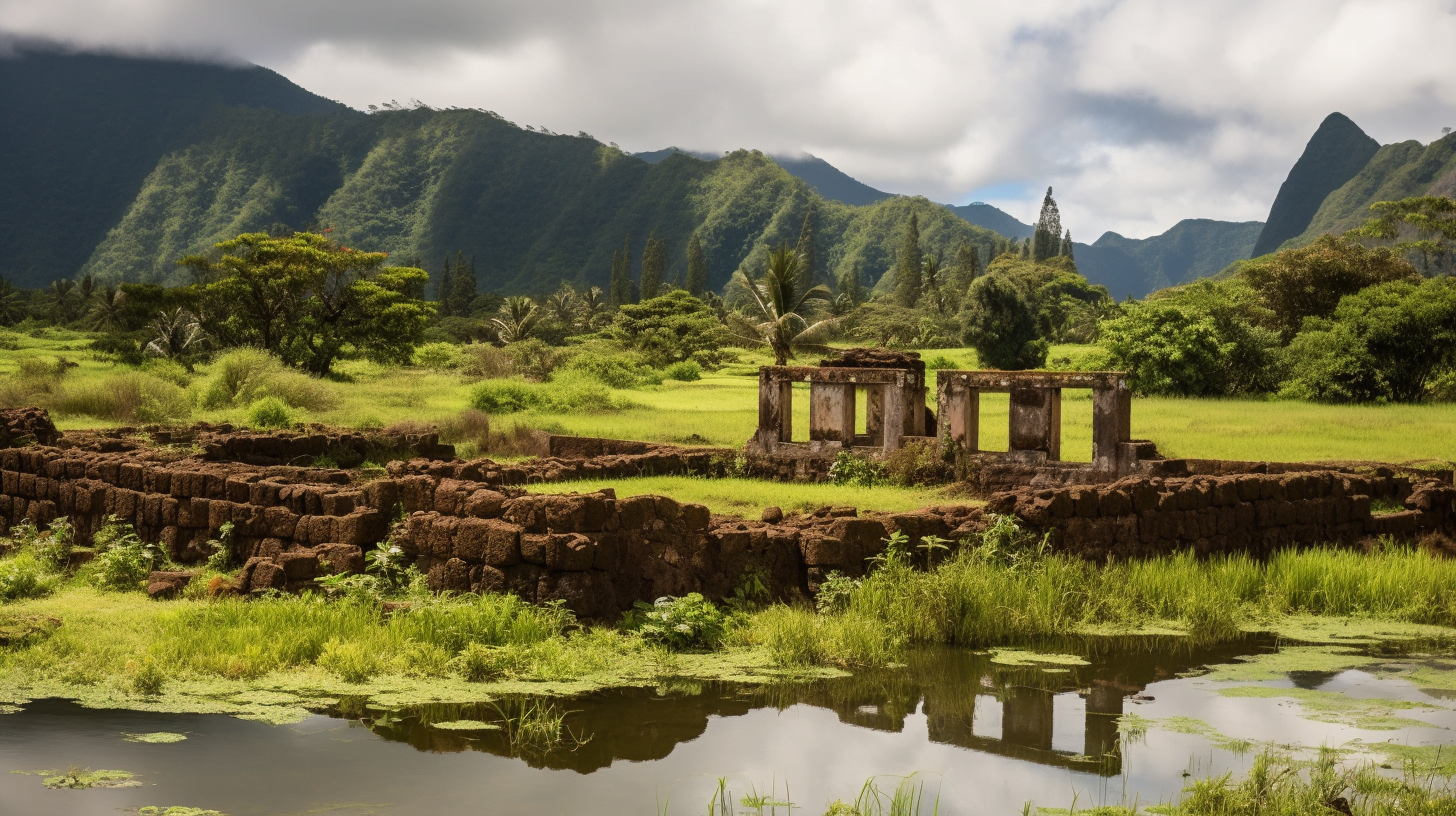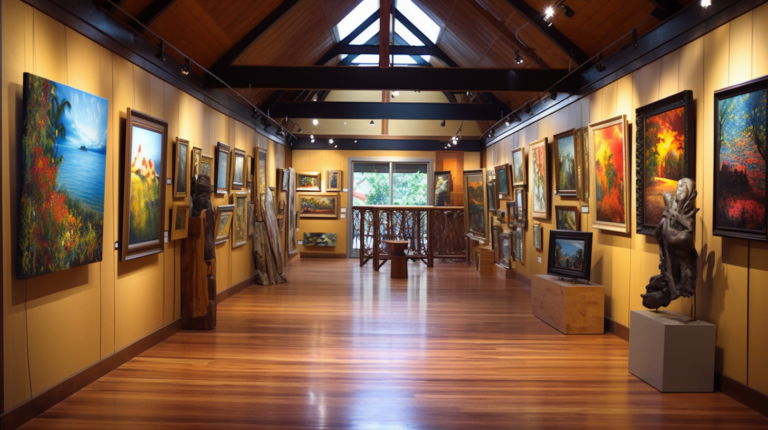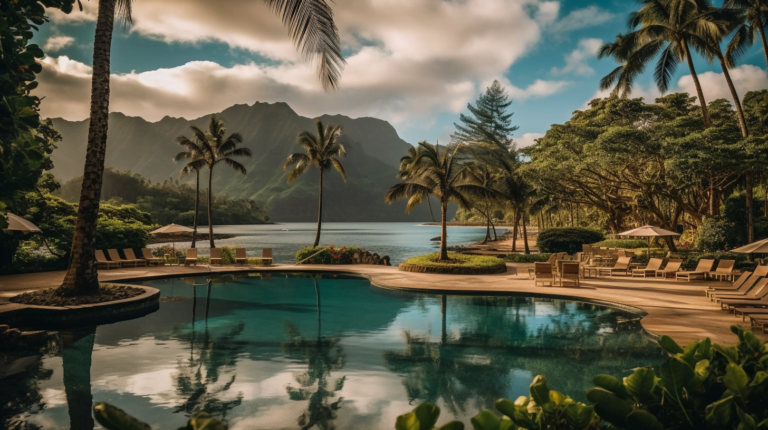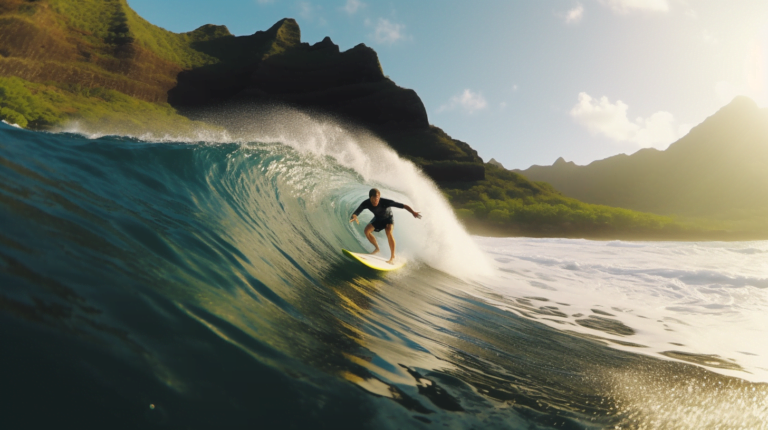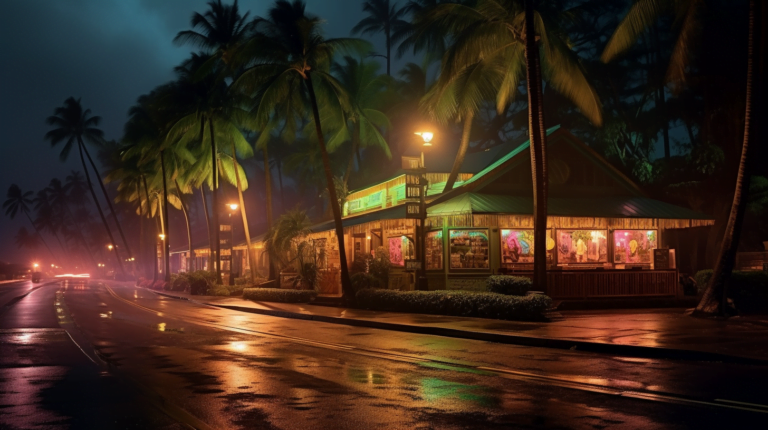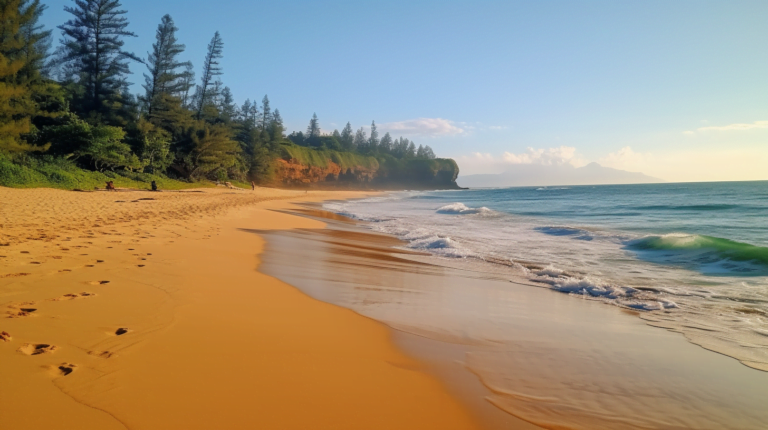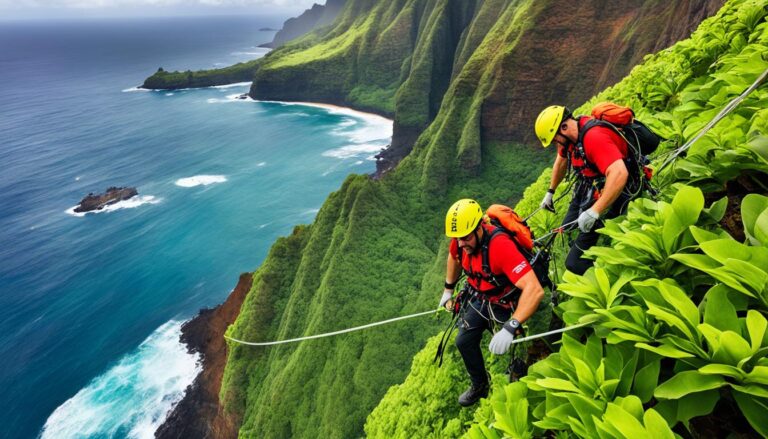Uncovering Kauai’s Rich History and Culture 🌺
Kauai is a Hawaiian Island that has a rich history and culture, with many historic places and landmarks to explore. The Historic Hawaii Foundation is a non-profit organization that works to preserve and protect historic properties throughout the islands, including Kauai’s many historic sites. Many of Kauai’s historic landmarks and sights are listed on the Hawaii State Register of Historic Places, recognizing their significance to the state’s history and culture.
The Garden Island is home to a wealth of artifacts and places that offer insight into the island’s past, including ancient Hawaiian heiau (temples), plantation-era buildings, and more. These historical attractions provide an opportunity for visitors to learn about Kauai’s unique history while enjoying its beautiful scenery.
One notable historic site on Kauai is Lawai International Center. This center features a restored Buddhist temple and other structures that reflect the island’s multicultural heritage. The center offers tours that showcase its history as well as meditation sessions in the temple.
Another must-see attraction on Kauai is Waimea Canyon State Park. Known as the “Grand Canyon of the Pacific,” this park offers breathtaking views of red rock formations, waterfalls, and lush greenery. Visitors can also learn about the geological history of the area at the park’s museum.
For those interested in learning about Kauai’s plantation era, a visit to Kilohana Plantation is a must. This 105-acre estate includes a beautifully restored plantation house, train rides through fields of sugarcane, gardens filled with tropical plants, shops selling locally-made crafts, and restaurants serving traditional Hawaiian cuisine.
In addition to these popular attractions, there are numerous other historical sites scattered throughout Kauai such as Hanapepe Town which was once known for its sugar plantations but now serves as an art district or Wailua River State Park where visitors can see ancient Hawaiian temples or heiaus.
Historic properties on Kauai are assigned a SHPD Historic Site Number by the State Historic Preservation Division, helping to ensure their preservation for future generations. This designation is important as it recognizes the cultural significance of these sites and helps protect them from development or destruction.
Kauai’s Historic Places and Districts: A Brief Overview
Hanapepe Town Historic District: A Step Back in Time
Located on the southern coast of Kauai, the Hanapepe Town Historic District is a charming area that showcases the town’s plantation history. Recognized by the State Historic Preservation Division, this district is home to several preserved buildings from the early 1900s, including a theater and an old fire station. Visitors can stroll through the streets and admire the quaint storefronts and colorful murals that adorn many of the buildings.
One of the highlights of this historic district is Friday Art Night, a weekly event where galleries and shops stay open late to showcase local art and live music performances. This event provides visitors with a unique opportunity to experience Hanapepe’s vibrant arts scene while also learning about its rich history.
Koloa Town Historic District: The Birthplace of Hawaii’s Sugar Industry
Located on Kauai’s south shore, Koloa Town was once home to Hawaii’s first commercial sugar plantation. Today, visitors can explore this historic district and learn about its role in shaping Hawaii’s economy during the 19th century. The Koloa Sugar Mill still stands as a testament to this industry, and visitors can take a self-guided tour through its ruins.
In addition to its sugar-related history, Koloa Town also boasts several preserved buildings from the 1800s. Among these are St. Raphael Church and Old Koloa Town, which features restored plantation-era homes that now serve as shops and restaurants.
Waimea Town Historic District: Where Captain Cook First Landed in Hawaii
The Waimea Town Historic District is located on Kauai’s west side and is known for being where Captain Cook first landed in Hawaii in 1778. Today, visitors can explore this historic district and learn about its significance to Hawaiian culture.
Among its many historic buildings are two churches – St. Theresa Church (built in 1846) and Waimea United Church of Christ (built in 1911) – as well as the Russian Fort Elizabeth State Historical Park. This park features the remains of a fort that was built by Russian explorers in the early 1800s.
Wailua Complex of Heiaus: A Window into Ancient Hawaiian Culture
Located on Kauai’s east side, the Wailua Complex of Heiaus is a collection of sacred Hawaiian temples that date back to the 14th century. Visitors can explore this site and learn about its significance to ancient Hawaiian culture. Among its many structures are four heiaus (temples), including Hikinaakala Heiau, which is believed to have been used for astronomical observations.
Kilohana Plantation Estate: A Glimpse into Kauai’s Plantation Era
The Kilohana Plantation Estate is located on Kauai’s southeast side and offers visitors a glimpse into the island’s plantation era. This restored plantation home features period furnishings and decor, as well as guided tours that provide insight into what life was like for those who lived and worked on these plantations.
In addition to its historic home, Kilohana also boasts several shops and restaurants that offer locally-made goods and farm-to-table cuisine. Visitors can take a train ride through the estate’s orchards or enjoy a stroll through its beautifully landscaped gardens.
Top 10 Must-Visit Historical Landmarks in Kauai
Waimea Canyon State Park: Witness the “Grand Canyon of the Pacific”
Waimea Canyon State Park is one of the most popular attractions in Kauai, known for its stunning views and geological history. Often referred to as the “Grand Canyon of the Pacific,” this park features a 14-mile long canyon that is over 3,000 feet deep. The canyon was formed by erosion from the Waimea River and subsequent landslides.
Visitors can explore several hiking trails that offer breathtaking views of the canyon, including the popular Waimea Canyon Trail and Kukui Trail. The park also offers lookout points where visitors can take in panoramic views of the canyon and its vibrant reds, greens, and browns.
Kilauea Lighthouse: A Symbol of Kauai’s Maritime History
Built in 1913, Kilauea Lighthouse stands as a symbol of Kauai’s maritime history. Located on a rocky peninsula on the island’s north shore, this lighthouse offers breathtaking views of the ocean and surrounding cliffs.
The lighthouse played an important role in guiding ships through dangerous waters during Hawaii’s sugar plantation era. Today, visitors can tour the lighthouse and learn about its fascinating history at the adjacent Kilauea Point National Wildlife Refuge Visitor Center.
Wailua River State Park: Discover Ancient Hawaiian Temples
Wailua River State Park is home to several historical sites that provide insight into ancient Hawaiian culture. Visitors can explore heiau (ancient temples) that were once used for religious ceremonies or visit Kamokila Village, a replica village featuring traditional Hawaiian huts.
The park also includes ruins from a 19th-century sugar plantation, providing a glimpse into Kauai’s agricultural past. Visitors can take guided tours or rent kayaks to paddle down Wailua River and explore these historical landmarks from a unique perspective.
Russian Fort Elizabeth State Historical Park: A Piece of Kauai’s Russian History
Russian Fort Elizabeth State Historical Park is a 20-acre park located on the island’s west side. The fort was built by Russian fur traders in the early 19th century and played a significant role in Hawaii’s history.
Visitors can explore the remains of the fort, including its walls and gun emplacements. Interpretive signs provide historical context for the site, which was once used as a trading post and strategic military outpost.
Grove Farm Homestead Museum: Step Back in Time to Kauai’s Plantation Era
The Grove Farm Homestead Museum offers visitors a glimpse into life on a sugar plantation in the late 19th and early 20th centuries. The museum features several historic buildings, including the plantation owner’s home, caretaker’s cottage, and sugar mill.
Visitors can take guided tours of the property to learn about Kauai’s agricultural history and see artifacts from everyday life during this era. The museum also hosts special events throughout the year, such as holiday celebrations and cultural festivals.
Discovering the Rich History of Waimea, Kauai’s Oldest Town
Waimea, Kauai’s oldest town, is a treasure trove of history that dates back to the 18th century. Once a bustling center of trade and commerce, Waimea was the first place where Captain James Cook set foot on Hawaiian soil in 1778. The town’s strategic location made it an important port for ships from all over the world, including Russia and China.
Russian Fort Elizabeth State Historical Park
One of Waimea’s most notable landmarks is the Russian Fort Elizabeth State Historical Park. This fort was built by Russian fur traders in 1817 as a base for their operations in Hawaii. Today, visitors can explore the ruins of the fort and learn about its fascinating history.
Waimea Plantation Cottages
Another must-visit attraction in Waimea is the Waimea Plantation Cottages. These historic cottages were once home to plantation workers during Hawaii’s sugar industry boom. Today, they have been renovated into charming vacation rentals that provide visitors with a glimpse into life on a Hawaiian plantation.
Wailua Complex
The Wailua Complex is another important historical site located near Waimea. This National Historic Landmark includes ancient Hawaiian temples and other cultural sites that offer insight into Hawaii’s rich history and culture.
By exploring these historic buildings and landmarks in Waimea, visitors can gain a deeper appreciation for Kauai’s unique past. From learning about early European explorers to understanding Hawaii’s sugarcane industry, there is so much to discover in this charming town.
Exploring Kauai’s Royal Past: The Birthplace of Prince Jonah Kuhio Kalanianaole
Prince Jonah Kuhio Kalanianaole was a prominent figure in Hawaiian culture and politics. He was born in Hanalei Bay, Kauai, which is a significant location in Hawaiian history as it was visited by Captain James Cook during his exploration of Hawaii. Today, visitors can explore the birthplace of Prince Kuhio at Ka Ulu, a historical site located near Hanalei Pier.
Exploring the Birthplace of Prince Jonah Kuhio Kalanianaole
Ka Ulu is a must-visit attraction for those interested in Hawaiian culture and history. The site offers a glimpse into the rich history of Hawaii and the life of Prince Kuhio. Visitors can learn about his contributions to Hawaiian culture and politics, including his efforts to preserve traditional Hawaiian practices and establish the Hawaiian Homes Commission.
The site features several exhibits that showcase artifacts from Prince Kuhio’s life, such as photographs, clothing, and personal items. Visitors can also take a guided tour of the surrounding area to learn more about its significance in Hawaiian history.
Hanalei Bay: A Significant Location in Hawaiian History
Hanalei Bay played an important role in shaping Hawaiian history. It was visited by Captain James Cook during his exploration of Hawaii in 1778. Cook’s arrival marked the beginning of Western influence on Hawaii and ultimately led to its annexation by the United States.
Despite this tumultuous past, Hanalei Bay remains an important cultural hub for Hawaiians today. It is home to several traditional fishing villages where locals continue to practice traditional fishing techniques passed down through generations.
Visiting Hanalei Pier
In addition to exploring Ka Ulu and learning about Prince Kuhio’s life, visitors can also visit nearby Hanalei Pier. The pier offers stunning views of Hanalei Bay and is a popular spot for fishing and surfing.
Visitors can also take part in cultural activities such as hula dancing and lei making. These activities provide a unique opportunity to immerse oneself in Hawaiian culture and gain a deeper understanding of its significance.
Uncovering the Fascinating Story of the Menehune People at Alekoko Fishpond
Menehune Fishpond: Uncovering the Fascinating Story of the Menehune People
Menehune Fishpond is a hidden gem on Kauai’s south shore, known for its fascinating story of the Menehune people. The fishpond is believed to have been built by the Menehune, a mythical race of small people in Hawaiian folklore. According to legend, these small people were skilled builders and craftsmen who lived deep in the forests and valleys of Kauai. They were said to be shy and reclusive, only coming out at night to work on their projects.
The Menehune Fishpond features a unique irrigation system called the Menehune Ditch, which allowed fresh water from the nearby river to flow into the pond. This system was ahead of its time and was designed with such precision that it still functions today. The fishpond was used as a source of food for ancient Hawaiians and played an important role in sustaining their way of life.
Today, locals volunteer to maintain and preserve the fishpond, which serves as an important cultural and historical site on the island. Visitors can learn about the rich history of Kauai’s south shore by exploring this fascinating attraction. The site offers guided tours that provide insight into how this engineering marvel was constructed by hand using simple tools like rocks, sticks, and shells.
Russian Fort Elizabeth: Exploring Nearby Attractions
In addition to visiting Menehune Fishpond, visitors can explore nearby attractions such as Russian Fort Elizabeth. This fort was built by Russian explorers in 1817 as part of their plan to establish trade relations with Hawaii. Although it was never used for military purposes, it served as an important trading post for many years before being abandoned in 1853.
Today, Russian Fort Elizabeth is a popular tourist destination that offers visitors a glimpse into Hawaii’s past. The fort features a museum that displays artifacts and exhibits related to the site’s history. Visitors can also explore the fort’s grounds, which include a chapel, barracks, and gun emplacements.
Witnessing the Birth of King Sugar at Grove Farm Homestead Museum
First Sugar Plantation: Grove Farm Homestead Museum
Established in 1835, the Grove Farm Homestead Museum is a historical landmark that holds significant importance to Kauai’s history. It was the site of the first sugar plantation on the island, marking the beginning of an era that would shape Kauai’s economy and society for generations to come.
Sugar Plantation Tour
Visitors can take a tour of the sugar mill and farm buildings on the property, which offers an insight into how sugar was produced during its heyday. The museum features a restored plantation-era temple that provides visitors with a glimpse into Hawaii’s religious past. The temple is an example of how different cultures coexisted and influenced each other during this period.
Lydgate Farms and Fort Elizabeth Tours
The museum also offers tours of nearby Lydgate Farms and Fort Elizabeth, which are both steeped in history. Lydgate Farms is a family-owned business that specializes in growing organic fruits and vegetables, while Fort Elizabeth is a military fort built in 1816 by Russian explorers.
Impact of Sugar on Kauai’s History
Grove Farm Homestead Museum provides visitors with a unique opportunity to learn about the impact of sugar on Kauai’s history and economy. During its peak, sugar production was responsible for much of Kauai’s economic growth, providing jobs for thousands of people across the island. However, it also had negative consequences such as exploitation of workers from Asia who were brought over to work on plantations.
The Koloa Heritage Trail: A Journey Through Kauai’s Sugar Plantation Era
Kilohana Plantation: A Train Ride Through Kauai’s Sugar Plantation Era
One of the must-visit attractions in Kauai is the Koloa Heritage Trail. This trail takes visitors on a 10-mile self-guided tour through the island’s sugar plantation era. The trail features 14 stops, including the Kilohana Plantation, where visitors can take a train ride through the plantation’s grounds.
The Kilohana Plantation is a historic landmark that dates back to the early 1900s. It was once one of the largest sugar plantations in Hawaii and played a significant role in shaping Kauai’s economy during its heyday. Today, it has been transformed into a popular tourist destination that offers an insight into Hawaii’s past.
Visitors can hop aboard the Kauai Plantation Railway and take a scenic ride through the plantation’s lush gardens and orchards. The train ride takes approximately 40 minutes and provides an opportunity to see some of Hawaii’s exotic fruits such as papayas, mangoes, and pineapples up close. Along with this, visitors get to learn about how these fruits were grown and harvested during the sugar plantation era.
Koloa Landing: A Historic Port for Sugar and Pineapple Exports
Another stop along the Koloa Heritage Trail is Koloa Landing. This site was once a bustling port for sugar and pineapple exports during Hawaii’s golden years of agriculture. The landing played an essential role in transporting goods from various plantations to other parts of Hawaii and beyond.
Today, visitors can stroll along this historic site while taking in breathtaking views of Poipu Beach Park. They can also learn about how sugar cane was processed at nearby mills before being transported out via ships anchored at Koloa Landing.
Belt Road: Connecting Sugar Plantations for Efficient Transportation
One unique aspect of the Koloa Heritage Trail is that it follows the original “belt road” that connected Kauai’s sugar plantations. This road was built in the early 1900s and allowed for efficient transportation of goods between different plantations.
The belt road played a significant role in shaping Kauai’s economy during the sugar plantation era. It enabled farmers to transport their crops quickly from one plantation to another, leading to increased productivity and profitability. Today, visitors can drive along this historic route while learning about its significance and impact on Kauai’s history.
An In-Depth Look into the Natural History of Kauai at the Koke’e Natural History Museum
Koke’e Natural History Museum: A Fascinating Journey through Kauai’s Natural History
Located within the Koke’e State Park on the north shore of Kauai, the Koke’e Natural History Museum is a must-visit destination for those interested in exploring the island’s natural history. The museum features an impressive collection of exhibits that showcase Kauai’s natural resources, including geology, flora and fauna, and Hawaiian culture.
Amazing Collections at Koke’e Natural History Museum
The museum boasts an array of amazing collections that will leave visitors in awe. One such exhibit is the lava rock display, which showcases the geological formations found on the island. Visitors can learn about how these formations were created and how they have shaped the landscape over time. Another exhibit not to be missed is the coastal ecosystems exhibit, which highlights the unique flora and fauna found along Kauai’s coastline.
In addition to these exhibits, visitors can also explore other areas of interest within the museum. The Hawaiian culture exhibit provides insight into the traditions and customs of Hawaii’s indigenous people. Here you can learn about their way of life, including their beliefs and practices related to nature.
Take a Tour of Koke’e Natural History Museum
For those who want a more immersive experience, taking a tour of the museum is highly recommended. Knowledgeable guides will lead you through each exhibit while providing fascinating insights into Kauai’s natural history.
Hiking Opportunities at Koke’e State Park
After exploring all that the museum has to offer, visitors can continue their journey by hiking through Koke’e State Park. The park offers several trails with varying degrees of difficulty that provide stunning views of Waimea Canyon and Kalalau Valley.
Listed on National Register of Historic Places
It is worth noting that in addition to its educational value, the Koke’e Natural History Museum holds significant historical importance as well. It is listed on both Hawaii’s Register of Historic Places and the National Register of Historic Places.
A Comprehensive Guide to Kauai’s Historical Sites and Attractions
Top Recommended Visits According to Tripadvisor LLC
Kauai, also known as the “Garden Isle,” is home to a number of historic sites that offer visitors a glimpse into the island’s rich cultural heritage. From ancient Hawaiian traditions to more recent history, Kauai’s historical attractions have something for everyone.
According to Tripadvisor LLC, some of the top recommended visits include the Kilohana Plantation Estate, Waimea Canyon State Park, and the Kilauea Lighthouse. The Kilohana Plantation Estate is a beautiful 1930s estate that offers visitors a chance to step back in time and experience life on an old sugar plantation. Visitors can take a train tour through the estate’s gardens and orchards or dine at one of its restaurants.
Waimea Canyon State Park is another popular attraction among tourists. Known as the “Grand Canyon of the Pacific,” this park offers stunning views of deep valleys and rugged cliffs. Visitors can hike along one of its many trails or take a scenic drive through its winding roads.
The Kilauea Lighthouse is another must-see attraction on Kauai. Built in 1913, this lighthouse sits atop a rocky bluff overlooking the ocean. Visitors can climb to the top for breathtaking views or explore its museum exhibits on local marine life and island history.
Taking A Guided Tour with Local Expert Tip
While these attractions are certainly worth visiting on their own, taking a guided tour with a local expert can provide visitors with even deeper insight into Kauai’s history and culture. One Tripadvisor member suggests taking such tours as they offer unique perspectives that cannot be found in guidebooks or online resources.
A guided tour can help visitors learn about ancient Hawaiian traditions such as hula dancing and lei making while also providing historical context for sites like Hanalei Bay or Wailua River State Park. Local guides may share personal stories about growing up on the island, giving visitors a more intimate understanding of Kauai’s culture and way of life.
Whether you’re interested in learning about ancient Hawaiian traditions or the island’s more recent past, Kauai’s historical attractions offer something for everyone. From stunning natural wonders to beautifully preserved historic sites, there is no shortage of things to see and do on this beautiful island. So why not take a guided tour with a local expert tip to gain an even deeper appreciation for all that Kauai has to offer?
Conclusion
Kauai is a treasure trove of historical landmarks and attractions that offer an insightful glimpse into the island’s rich cultural heritage. From ancient fishponds to royal birthplaces, sugar plantations to natural history museums, Kauai has something for everyone interested in exploring its fascinating past.
One of the must-visit historical places on the island is Waimea, Kauai’s oldest town. This charming town dates back to the early 19th century and was once a bustling center of commerce and trade. Today, visitors can explore its historic buildings and sites such as the Russian Fort Elizabeth State Historical Park and Captain Cook Landing Site.
Another must-see attraction is Alekoko Fishpond, also known as the Menehune Fishpond. According to legend, this ancient fishpond was built by the Menehune people, who were believed to be skilled craftsmen with supernatural powers. Visitors can marvel at the impressive engineering feat of this stone-walled pond while learning about its fascinating history.
For those interested in Kauai’s royal past, a visit to Prince Jonah Kuhio Kalanianaole Birthplace is a must. This historic site marks the birthplace of Hawaii’s beloved Prince Jonah Kuhio Kalanianaole, who played a significant role in preserving Hawaiian culture and traditions during his lifetime.
Grove Farm Homestead Museum offers another unique glimpse into Kauai’s history. This former sugar plantation estate showcases life on a working plantation during Hawaii’s plantation era in the late 1800s and early 1900s. Visitors can tour the beautifully restored main house and learn about life on a sugar plantation through interactive exhibits.
The Koloa Heritage Trail takes visitors on a journey through Kauai’s sugar plantation era with stops at various historic sites such as Old Sugar Mill of Koloa and Spouting Horn Park. Along this scenic trail, visitors can learn about the island’s rich sugar plantation history and its impact on Kauai’s culture and economy.
For those interested in natural history, a visit to Koke’e Natural History Museum is a must. This museum offers an in-depth look at Kauai’s unique ecosystem, including its native flora and fauna, geology, and climate. Visitors can also explore nearby hiking trails and scenic overlooks for breathtaking views of the island’s natural beauty.
Be sure to visit our guide on Kauai Attractions for more information on things to do in Kauai.

